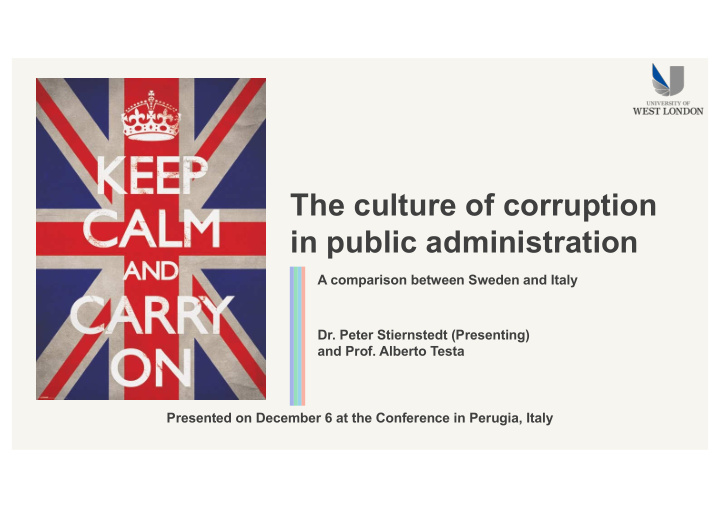



The culture of corruption in public administration A comparison between Sweden and Italy Dr. Peter Stiernstedt (Presenting) and Prof. Alberto Testa Presented on December 6 at the Conference in Perugia, Italy
Introduction What to expect from this presentation The project The observation The report The framework The countries The lenses The cases The impact
The project A study on corruption in Sweden by comparing it to Italy by some guys in the UK Sir Isac Newton
The observation Trust Transparency Truth
Corruption in Swedish public administration Korruption i Myndighetssverige (Brå, 2014) • In 2014 the Swedish National Council for Crime Prevention published the report "Corruption in government agencies”. • The report presents a study that focuses on corruption that seeks to influence the core domain of the work of public sector agencies – the exercise of public authority. • The results and conclusions of the report can be summarised as follows: Research on corruption remains limited. • The Swedish Anti-Corruption Institute, emphasised the importance of the four cultures that increase the risk for corruption.
The methodological framework The four cultures conducive to corruption Blindness Silence Informal rules Efficiency [Blindhet] [Tystnad] [Informella regler] [Effektivitet] “Corruption “Mind your “Rationalisations “Choosing cannot own favourable to and creating occur here.” business.” deviance.” shortcuts.”
Countries of analysis Do not use the CPI as a time-series! For the third year running, the top seven countries in the Corruption Perceptions Index 2018 consist of the four Nordic nations – Denmark, Finland, Sweden Points: 85/100 and Norway. All score Points: 52/100 between 84 and 88 points Rank: 3/180 Rank: 53/180 out of 100 on the index.
Theoretical lens Bourdieu’s (1989) micro-macro theory Habitus - Blindness Fields - Silence 01 02 Humans naively learn A network or configuration about the world and its of objective relations axioms in a pre-reflective between positions unconscious way. occupied by social actors. Capitals – Efficiency Doxa (logic) – Informal rules 03 04 Each field has dominant A product of a tacit (and dominated) actors agreement representing ranked in the order of what seems obvious and power they possess. normal in a field.
Criminological lens General Strain Theory (Agnew, 1992)
Case studies welcome An Italian stem with Swedish branches Coverage Discoveries Outcomes Other…?! Life-cycle • Multilevel Levels • Progressive • Context Tangentopoli • Impact
Impact on perceptions Educated guesses Level Silence Level Occurrence (Sub-)Culture seem more Frequency of discovering relevant on regional/local irregularities has increased. 01 02 than on national level. (Reduced strain) Solutions Informal rules Solutions A culture of truth, trust Compartmentalisation Reach and transparency? insulate wider recognition. 06 03 A culture of integrity? (Unchanged strain) Blindness Efficiency Attrition Management Progressive acceptance NPM reforms drives results of current state of affairs. based performance indicators. 04 05 (Reduced strain*) (Increased strain)
The culture of corruption in public administration Thank you Prof. Alberto Testa Dr Peter Stiernstedt for alberto.testa@uwl.ac.uk peter.Stiernstedt@uwl.ac.uk @DrATesta @omniumrerum listening! Presented on December 6 at the Conference in Perugia, Italy
Recommend
More recommend